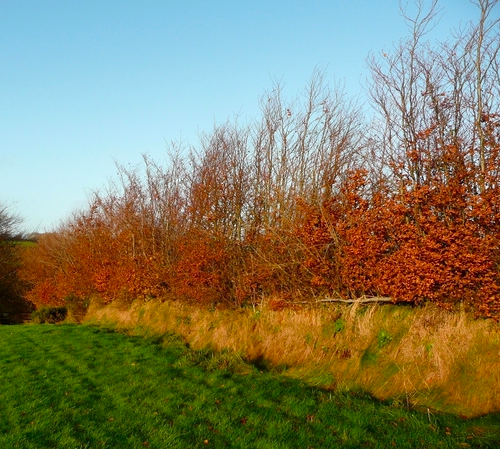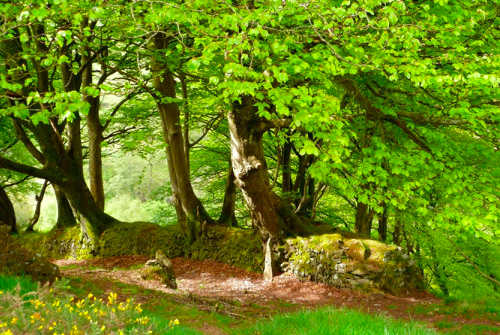The English landscape is unique, it is man made and it is made with local materials by local people to create localised landscapes. This allows for someone to travel across the country and discover the botany and geology of a region by looking at the materials used to construct the landscape.
Hedgerows illustrate this better than anything else. The style of hedge, the plants, the tools used to make it, are all indigenous to a region.
To build a hedge with stone, turf sods or by planting a line of suitable trees is not difficult. The skills needed can be taught and learnt easily, much more easily than the required skills needed to use building materials from a builders’ merchant or a DIY mega store. The ‘traditional knowledge’ is not the manufacturing process but is the local identity itself.
It is rare to see any new construction of hedgerows that reflect the local identity. The stones come from quarries far from site, the species mix of hedgerow plants is identical for miles and all the varying quirks that could identify the limits of a parish are now fast vanishing.
Large ‘landscaping’ schemes are carried out by national, sometimes multi national companies. Staff are paid minimum wages and are often untrained. The resulting hedge proves this despite the best efforts of landscape architects and planners.
The majority strength of the British landscaping industry are small businesses, often one man bands. They have little representation and face a wall of bureaucracy which seems to be against them at all times. The wages are poor and criticism great. They do the work because they love it and furthermore want to be able to contribute to their local landscape.
Over the last twenty years armies of volunteers invited and encouraged by NGOs have unwittingly removed the livelihood of the local hedge layer, stone waller or woodsman.
Therefore often the last remaining habitat for the traditional landscaper to find work in is the British garden.
England is small, it has a large population for its size and the English like to live in houses with land. The garden landscape is not only huge but vitally important for the preservation of a landscape as well as for conservation purposes. Yet desires born from watching nationwide television and reading nationwide magazines, fashion the wants of a client to insist upon using materials and plants which are usually from a foreign source and a ‘Groundforce-esque’ garden landscape, stretches from Lands End to John O Groats. The landscaper has to adapt to suit the clients desire.
But some of us, including myself, are lucky to live in regions where the landscape itself draws people to it and these people wish to embody this landscape within the confines of their property. Thus the art of Cornish stone walling & hedging is kept alive.
To complete a stone walled hedge requires a relevant species mix atop it. This helps to bind the hedge together. And the resulting trees help to bind the landscape together.
In Cornwall and many other places the dominant hedgerow tree can change from parish to parish. The climate and topography ensure this. To simply nip out to the garden centre and purchase ‘hedge’ trees defeats the purpose of the hedgerow. And no matter where you are in the British Isles the need to identify the tree mix in the nearest hedgerow is essential in ensuring the success of a new hedge.
The Hedgerow Act 1997 does little to protect remnant hedgerows, there is no protection at all awarded to garden hedgerows and as much as twenty metres can be destroyed without planning approval. Even the argument for removal is often stronger than any put forward for its retention.
Both the hedgerow and those that can build, plant and maintain them are in decline. This is in spite of their being quintessential attributes in the English landscape. In spite of their natural and cultural heritage and in spite of their role in defragmenting habitats and crossing boundaries between the urban, garden, country and woodland landscape.
The need for the Forestry Commission to have an expanded remit to help protect and enhance hedgerows is apparent. With the full protection of hedgerows those that work with them are protected also and the individual styles that relate a hedgerow to its locality can remain preserved.
Shane Kneebone is a sustainable land manager, tree and plantsman, stone waller and nurseryman.
www.cornishgardenlandscaping.co.uk






























Shane,
Well said mate.
On an island of increasingly fragmented habitats hedges are even more crucial to their, and the species they support, long term survival. The Hedgerow regs are a poor attempt (no teeth) at recognising this. I have tried, unsuccessfully so far, to generate some interest in assessing and mapping local hedgerows using DEFRA’s suggested standard methodology. The reasoning being that you should have a clear understanding of the existing ecological/habitat network before removing parts of it. Even hedges under 30m can be a key element of a network. There are too many decisions being made (particularly when ecology – ‘that so woolly science’ is involved) with no baseline data guiding them, a whoful state of affairs.
Hi Shane,
Cornish hedges are indeed a type on their own and its good that the tradition- and all hedgerow traditions-are kept alive where they can be.
We have lost in the region of 50% of our hedgerows but that still leaves 477,000km of hedgerows according to the 2007 Countryside Survey, and only 31% of these were in favourable condition (according to the Defra Standard) at the time of the survey. There just aren’t enough hedgelayers in the country to manage these appropriately (nor money to pay for them), so appropriately trained volunteers and land-managers have to play a role if well-managed hedges are going to play a part in connecting fragmented landscapes. A rejuvinated hedge, even if coppiced or managed by an amateur, provide better habitat for wildlife than one left to deteriorate and disappear-or get grubbed out! Addmittedly though, some hedgelaying styles require a lot more skill-the cornish style being a prime example.
Perhaps there is a need for networks of prestige hedges in each county, examples of high quality, expertly maintained and well-connected hedgerows, I wonder if people would be willing to pay from their own pocket to help create these?
At PTES we’ve been trying hard in the past three years to work with landowners, landmanagers, hedgelayers and the public to improve the health of hedgerows and increase connectivity for a range of species but especially the hazel dormice. You can see a copy of our final newsletter (the project has come to an end of its funding) here http://ptes.org/files/1424_hfd_newsletter.pdf
PTES are also a member of Hedgelink (www.hedgelink.org.uk), which is an umbrella organisation of statutory agencies, NGOs and other interested groups (NHLS, RSPB, CPRE,Tree Council, inlcuding the NFU and CLA) working for the conservation of hedgerows in the UK.
There is a forum on Hedgelink for discussion about hedgerow topics but I’d welcome hearing from anyone through this website about their views on hedgerows which I can relay back to Hedgelink members.
Best wishes
Jim
Oops should mention I am the Hedgerows for Dormice Project Officer at PTES-at least I am until the end of June!
Still too many hedgerows being taken out for health & Safety eg. road splay visibility…’Education:’ I have laid a urban hedgerow next to a primary school as it was due to be taken out for footpath widening. Ths school kids saw me laying it for a week. It was the first time they had seen such a thing! Now it has comeback really nice. Gives me so much satisfaction to hv saved this habitat, cultural feature and educational hedge. rob the tree hunter http://www.treehunter.co.uk